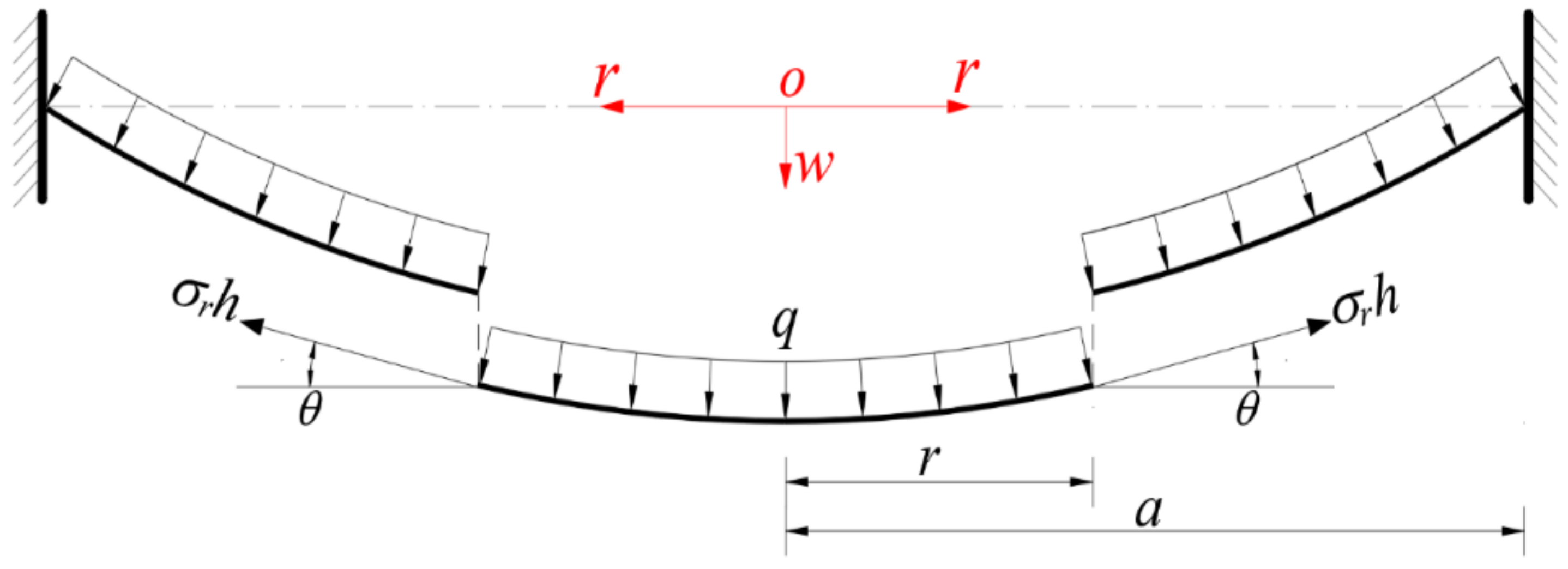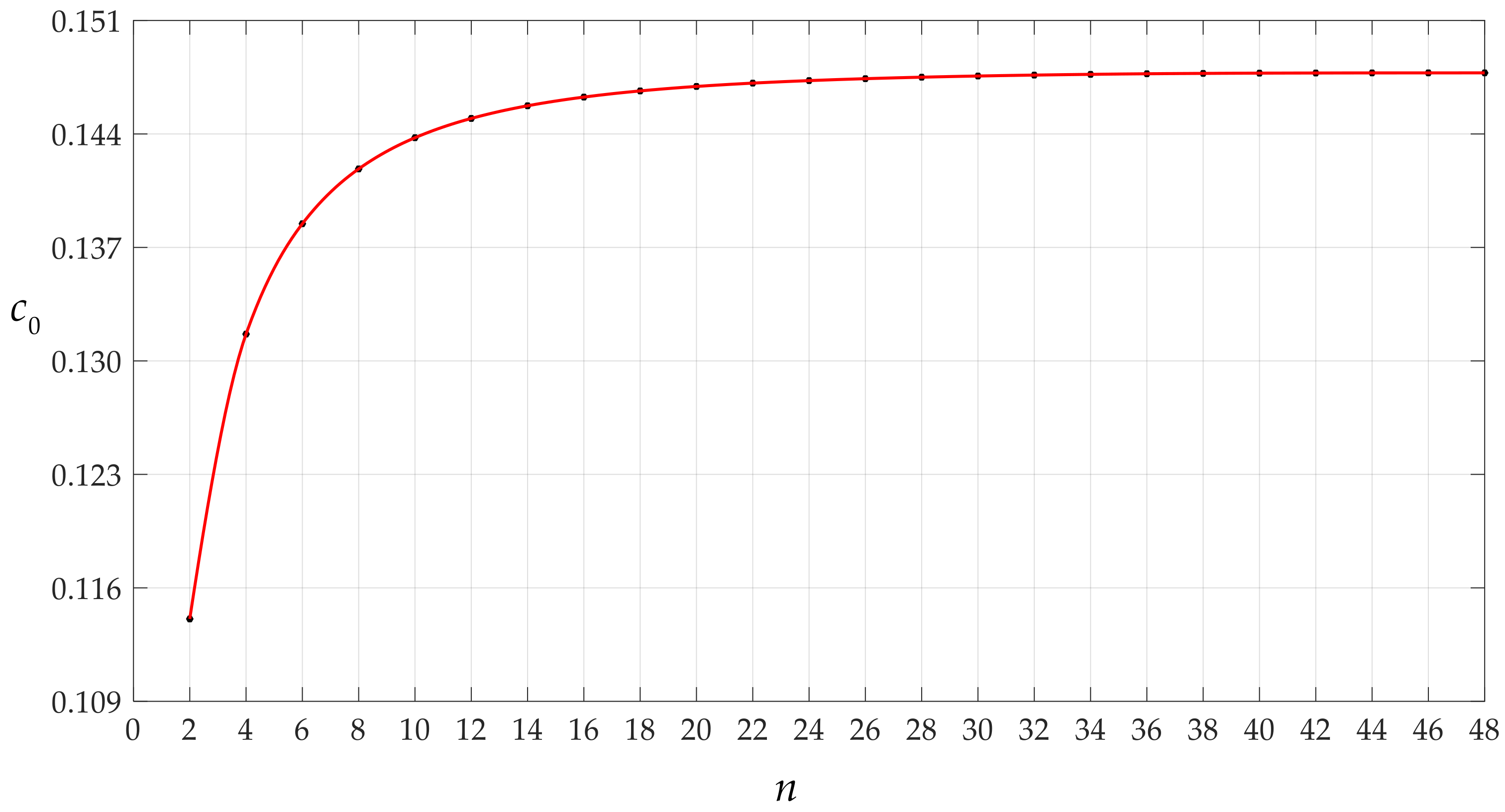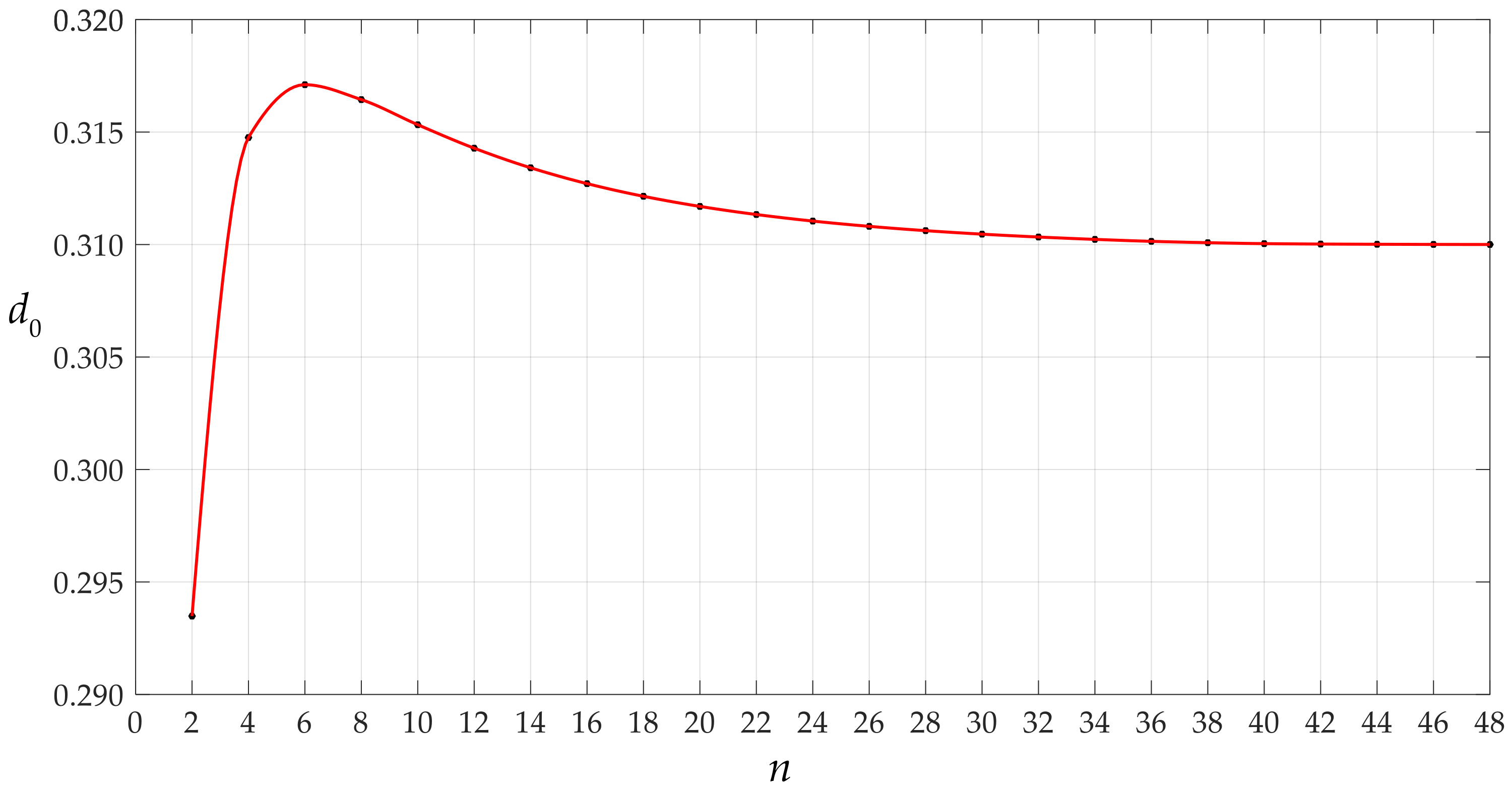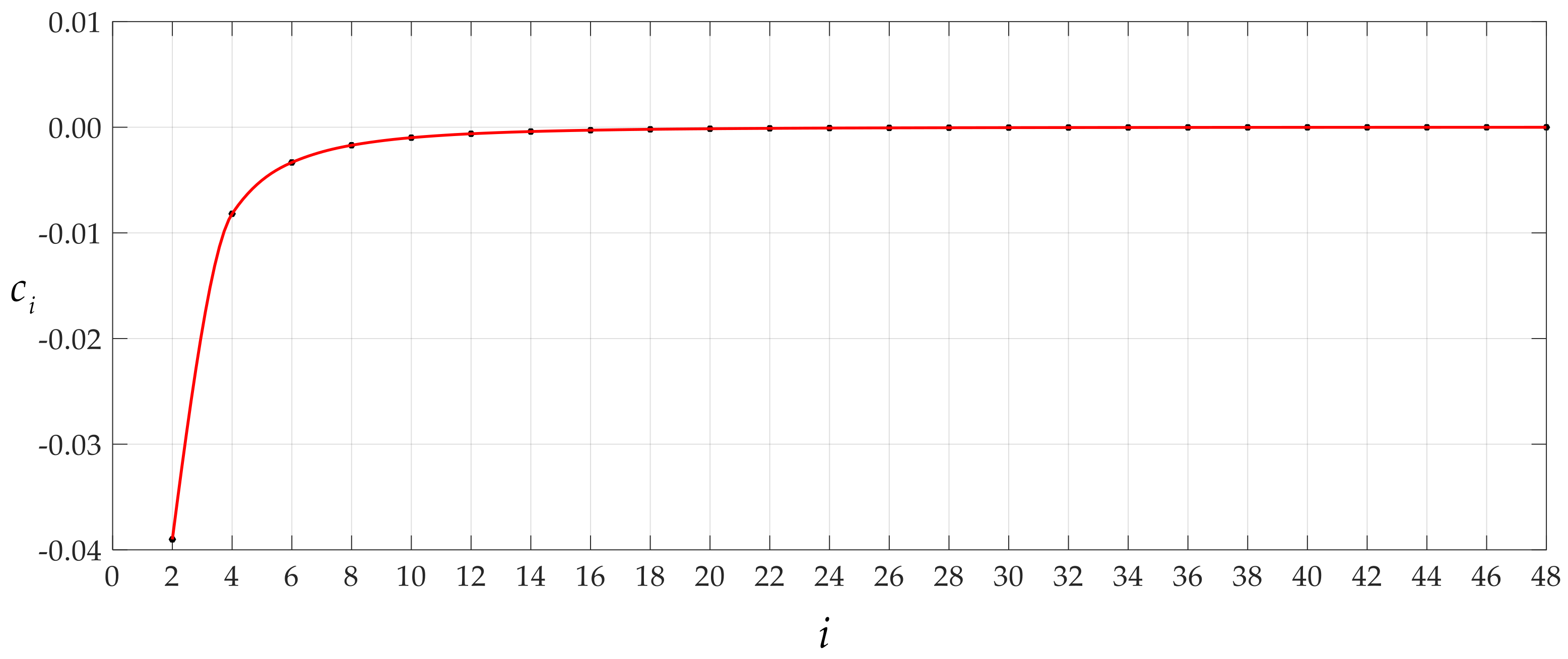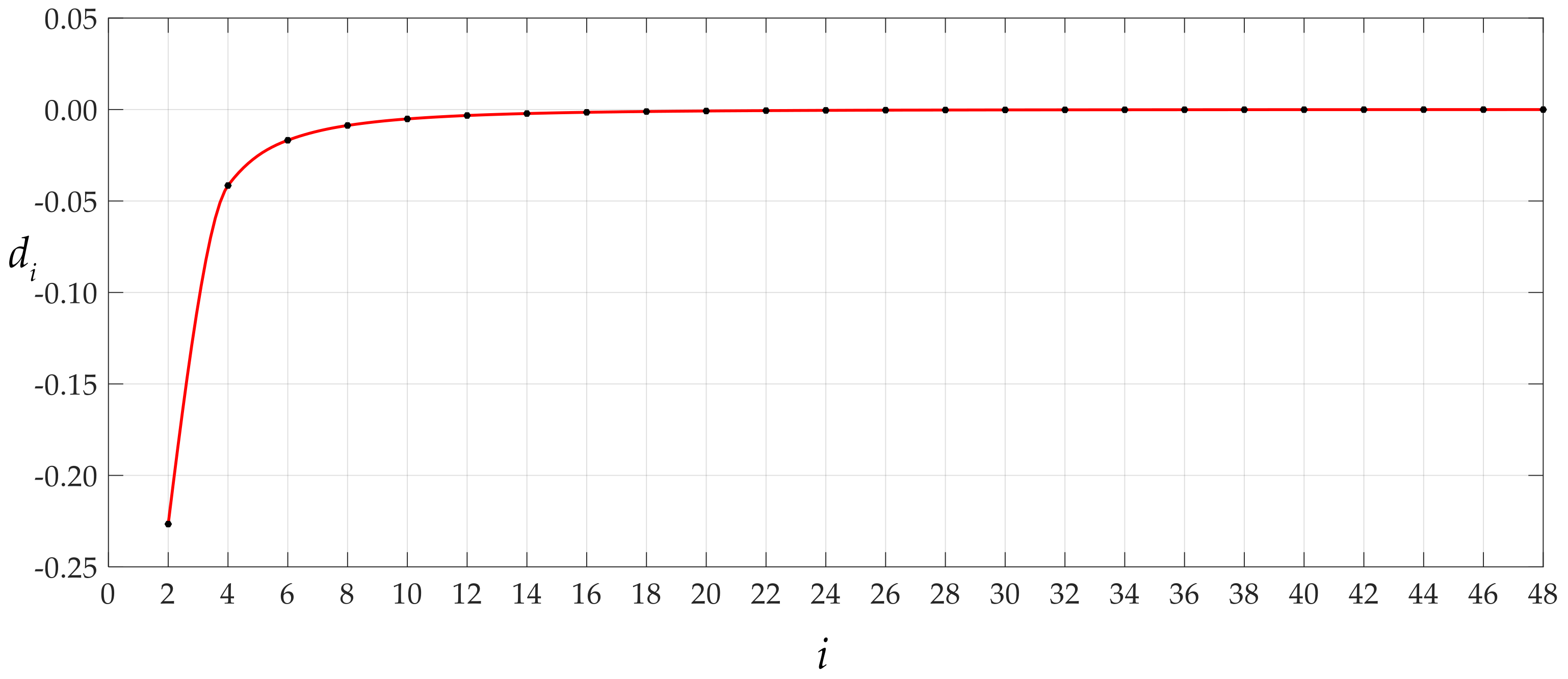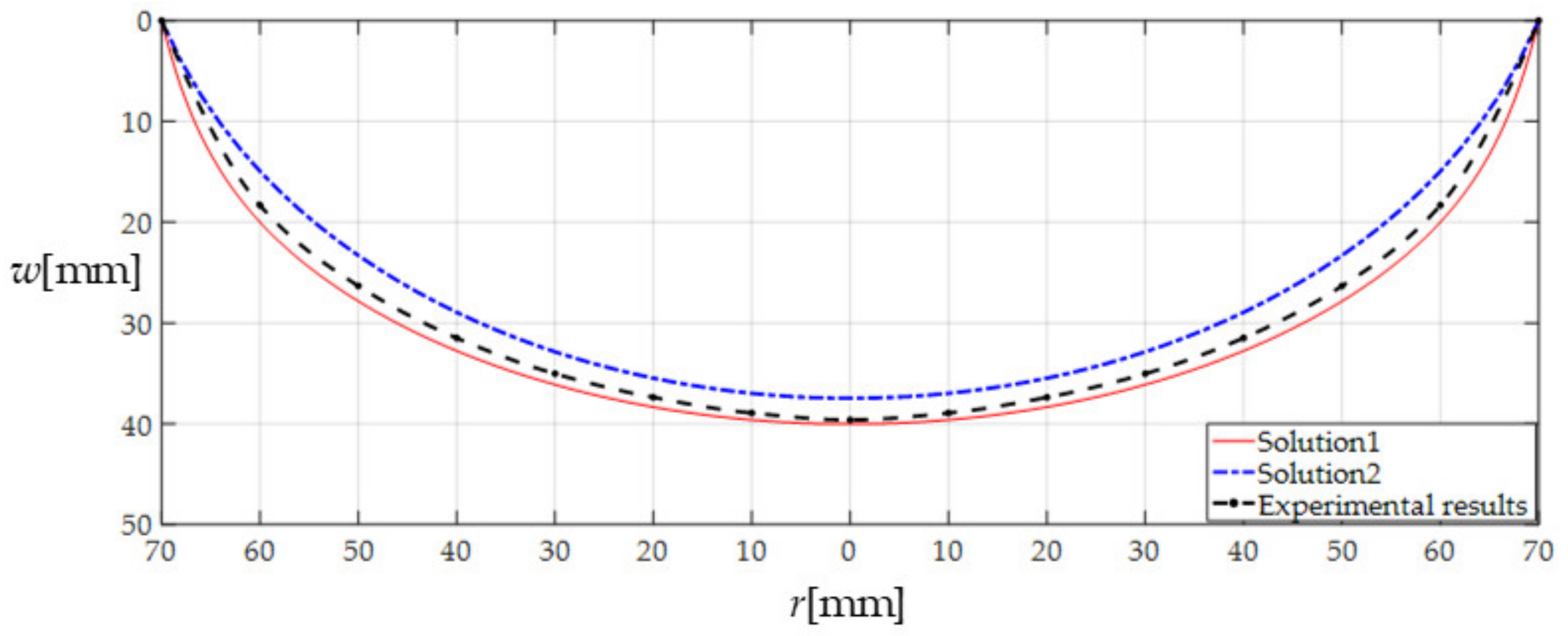1. Introduction
The so-called Föppl–Hencky membrane problem is well known: that is, the problem of large deflection of a peripherally fixed, initially flat circular membrane subjected to uniformly distributed out-of-plane loads. The initially flat circular membrane may be either stress-free or prestressed (by applying in-plane loads along the outer edge of the circular membrane before it is fixed), and the pre-stress can be either tensile or compressive, but in most cases it is tensile. The uniformly distributed out-of-plane loads is generally achieved by means of uniform transverse (lateral) or normal loading, where the uniformly distributed transverse loads refer primarily to the self-weight per unit area of the circular membrane in practice, while the uniformly distributed normal loads refer primarily to the gas or liquid pressure applied to the surface of the circular membrane. However, attention is mainly focused on the case of uniform transverse loading in the existing literature, while the closed-form solutions suitable for uniform normal loading are available in a few cases.
Föppl originally derived a system of equations of large deflection of membranes (thin plates with vanishing bending stiffness) from the classical Föppl–von Kármán equations of large deflection of thin plates [
1,
2,
3]. Hencky used the power series method to solve this system of equations for the case of a circular membrane under uniform loading, and presented the first analytical solution for the circular membrane problem [
4]. This is the reason why the circular membrane problem is usually called Föppl–Hencky membrane problem or simply well-known Hencky problem, but Hencky originally dealt only with the case of a stress-free circular membrane subjected to uniform transverse loading [
4]. A computational error in the power series solution which was presented originally by Hencky in 1915 [
4] was corrected subsequently by Chien in 1948 [
5] and Alekseev in 1953 [
6], respectively. This solution is usually called the well-known Hencky solution, and is often cited in some studies of related issues [
7,
8,
9,
10,
11,
12].
In the existing literature, however, the closed-form solutions of circular membranes subjected to uniform normal loading are available in a few cases [
13,
14,
15]. Fichter was the first scholar to deal analytically with the circular membrane problem for uniform normal loading, who presented an analytical solution of a stress-free circular membrane under gas pressure for the anticipated use for predicting the shape of orbiting inflatable reflectors [
13]. The horizontal component of the gas pressure applied is an extra component from the point of view of the problem for uniform transverse loading, and was really included during the mathematical formulation in [
13] but was actually neglected in Campbell [
14]. Therefore, the solution presented in Campbell [
14] was actually still suitable for the circular membrane problem for uniform transverse loading rather than uniform normal loading, although the title of the Campbell’s paper [
14] is “on the theory of initially tensioned circular membranes subjected to uniform pressure”. Shi et al. [
15] presented the closed-form solution for circular membranes under in-plane radial stretching or compressing and out-of-plane gas pressure loading, extending the closed-form solution presented in Fichter [
13] to include the case of pre-stress.
The closed-form solutions are often found to be necessary in some engineering or technical applications. In fact, the closed-form solutions suitable for uniform normal loading are far more often needed than the ones suitable for uniform transverse loading, for instance, the characterization of mechanical properties for freestanding thin films or thin-film/substrate systems based on pressured bulge or blister tests [
9,
16,
17,
18,
19,
20,
21], also including the anticipated use for predicting the orbiting reflector shape upon inflation [
13], all need the closed-form solution of a circular membrane subjected to uniform normal loading due to the fact that all of these circular membranes are actually subjected to gas pressure loading rather than uniform transverse loading. As has been described above, however, the opposite is true in the existing literature, where there are far more of the closed-form solutions suitable for uniform transverse loading than the closed-form solutions suitable for uniform normal loading. In particular, the calculation accuracy of the existing closed-form solutions suitable for uniform transverse loading has been greatly improved, while the calculation accuracy of the existing closed-form solutions for uniform normal loading [
13,
15] is far from ideal.
It may be observed from Fichter [
13] or Shi et al. [
15] that the closed-form solution presented was actually obtained under the condition that the rotation angle
θ of the circular membrane is so small that “sin
θ = tan
θ” can be used in place of “sin
θ = 1/(1 + 1/tan
2θ)
1/2”, which is usually called the small-rotation-angle assumption of the membrane (see Equations (37) or (2) in Fichter [
13] or Equations (1) through (3) in Shi et al. [
15]). This assumption inevitably leads to the loss of computational accuracy of the closed-form solutions, especially when the rotation angle
θ of the circular membrane is relatively large. However, in technical applications such as the mechanical properties characterization or orbiting inflatable reflectors mentioned above [
9,
16,
17,
18,
19,
20,
21], the rotation angle
θ of the circular membrane is often larger. Especially in the mechanical property characterization, the maximum deflection of the bulge or blister membrane may be close to the radius of the circular membrane, such that the rotation angle
θ may be as high as 50 degrees. In this case, if the small-rotation-angle assumption of membrane is adopted, then the calculation error which is caused only by substituting “sin
θ = tan
θ” for “sin
θ = 1/(1 + 1/tan
2θ)
1/2” is about 1.54% when
θ = 10 degrees, 6.42% when
θ = 20 degrees, 15.47% when
θ = 30 degrees, and 30.54% when
θ = 40 degrees. Therefore, it is necessary and worthwhile for these technical applications to give up the so-called small-rotation-angle assumption of membrane during the mathematical formulation of the problem under consideration.
In the following section, the problem of large deflection of a peripherally fixed, initially flat, stress-free circular membrane subjected to uniform normal loading is reformulated, where the small-rotation-angle assumption of membrane adopted in Fichter [
13] and Shi et al. [
15] (which are the only two relevant studies available in the literature)—the rotation angle of membrane
θ is assumed to be small so that “sin
θ = tan
θ” can be used in place of “sin
θ = 1/(1 + 1/tan
2θ)
1/2”—is given up, which makes the resulting nonlinear differential equation that governs the out-of-plane equilibrium more difficult to deal with analytically. The power series method is employed to analytically solve the resulting governing equations, and a new and more refined closed-form solution for the reformulated problem is finally presented. Due to giving up the small-rotation-angle assumption of membrane, i.e., using “sin
θ = 1/(1 + 1/tan
2θ)
1/2” rather than using “sin
θ = tan
θ” as Fichter [
13] or Shi et al. [
15] did, the closed-form solution presented here can be suitable for the larger rotation angle of membrane, in comparison with the only two relevant closed-form solutions presented by Shi et al. [
15] and Fichter [
13]. In
Section 3, the validity of the closed-form solution obtained in
Section 2 is proved firstly from the point of view that it can satisfy the boundary condition that is not used during its derivation. The convergence of the closed-form solution obtained in
Section 2 is numerically investigated due to the complexity of coefficient expressions arising from power series method, showing that the special solutions of stress and deflection converge very well. It is also numerically shown that the closed-form solutions presented in this paper and the one presented in Shi et al. [
15] or in Fichter [
13] agree quite closely for lightly loaded small-rotation-angle membranes and gradually diverge slowly as the rotation angle of membrane or the loads applied intensifies. Finally, a confirmatory experiment is used to show that the closed-form solutions presented in this paper is indeed improved in accuracy and adaptability to the rotation angle of membrane, compared to the only two existing solutions presented by Fichter [
13] and Shi et al. [
15]. Concluding remarks are given in
Section 4.
2. Membrane Equation and Its Solution
A linearly elastic, initially flat, stress-free circular membrane with thickness
h, Poisson’s ratio
v, and a Young’s modulus of elasticity
E was fixed at the edge of radius
a, and then a gas pressure
q was applied to one side of the initially flat, peripherally fixed circular membrane, resulting in the deflection to the other side of the membrane, as shown in
Figure 1, where a cylindrical coordinate system (
r,
φ,
w) was introduced, whose coordinate origin
o was placed in the centroid of the geometric intermediate plane of the initially flat circular membrane, the polar coordinate plane (
r,
φ) was located in the plane in which the geometric intermediate plane was located,
r denoted the radial coordinate,
φ denoted the angle coordinate but is not shown in
Figure 1,
w denoted the axial coordinate which is consistent with the deflecting direction of the circular membrane. Let us take out a free body from the central portion of the whole deflected circular membrane, a piece of circular membrane with radius
r (0 ≤
r ≤
a), with a view of studying the static problem of equilibrium of the free body under the joint actions of the membrane force
σrh at the boundary of the free body and the gas pressure
q, as shown in
Figure 2, where
σr is the radial stress,
h is the membrane thickness, and
θ is the rotation angle of the deflected circular membrane, which varies with radial coordinate
r.
In the vertical direction perpendicular to the polar coordinate plane (
r,
φ), there are two vertical (transverse) forces, i.e., the vertical external force
πr2q (0 ≤
r ≤
a) produced by the gas pressure
q and the vertical component 2π
rσrhsin
θ of the membrane force
σrh. Therefore, it can be found, from the condition of the resultant force being zero at the vertical direction, that the usually so-called out-of-plane equilibrium equation is
where
Substituting Equations (2) into (1) yields.
It may be seen, by comparing Equation (2) in this paper with Equation (2) in Shi et al. [
15], that the so-called small-rotation-angle assumption of membrane has been given up in the out-of-plane equilibrium equation, Equation (3). We still use the in-plane equilibrium equation derived originally by Fichter [
13].
where
σt denotes the circumferential stress. Suppose that the radial strain is denoted by
er, the circumferential strain is denoted by
et, the radial displacement at
r is denoted by
u(
r) and the transversal displacement at
r is denoted by
w(
r). Then the relations of the strain and displacement, i.e., the so-called geometric equations, may be written as
and
The relations of the stress and strain are still assumed to satisfy the generalized Hooke’s law (the linearly elastic membrane), then the so-called physical equations are
and
Eliminating
er and
et from Equations (5) through (8) yields.
and
By means of Equations (4), (9), and (10), one attains.
Substituting the
u in Equation (11) into Equation (9) yields.
Equation (12) is commonly known as the consistency equation.
Equations (3), (4), and (12) are three differential equations concerning
σr,
σt, and
w, and the boundary conditions for determining the special solutions of
σr,
σt, and
w are
and
Let us proceed to the following nondimensionalization.
and transform Equations (3), (4), and (12)–(15) into
and
Sr and
W can be expanded into the power series in the
x, due to the fact that the stress and deflection are both finite at
x = 0 (i.e., at
r = 0).
and
The recursive relations between
ci or
di can be determined by substituting Equations (23) and (24) into Equations (17) and (19), which results in that when
i is odd
ci ≡ 0 and
di ≡ 0, and when
i is even the coefficients
ci and
di can be expressed into the polynomial function in the coefficient
c0, see
Appendix A (for
ci) and
Appendix B (for
di).
The remaining two coefficients
c0 and
d0 are commonly known as the undetermined constants and can be determined by using the boundary conditions Equations (21) and (22). From Equations (23) and (24), the boundary condition Equation (21) yields.
Obviously, the substitution of
ci and
di (in
Appendix A and
Appendix B) into Equation (25) give rise to a univariate equation for
c0, and the solution to this univariate equation determines the specific value of the undetermined constant
c0. As a result, the expression of
Sr can be determined with the known
c0. Further, the boundary condition Equation (22) gives, from Equation (24).
Therefore, the value of the undetermined constant
d0 can be determined by Equation (26) with the known
c0, because
di is identically equal to zero when
i is odd and is the functions of
b0 when
i is even (see
Appendix B). The expression of
W can thus be determined with the known
c0 and
d0.
3. Results and Discussions
The boundary condition from Equation (13) or (20), which has not been used yet during the derivation above, can be used to exam the validity of the closed-form solution obtained in
Section 2. From Equation (24), the first derivative of the
W versus the
x is
It may be seen from Equation (27) that d
W/d
x ≡
d1 when
x = 0. However, from the derivation in
Section 2, we know that
d1 ≡ 0 because
di ≡ 0 when
i is odd. Therefore, it may be concluded that d
W/d
x ≡ 0 at
x = 0. This indicates that the boundary condition Equation (20) or Equation (13) can be naturally met by the closed-form solution obtained in
Section 2. This to some extent indicates that the derivation in
Section 2 is reliable.
The convergence of the power series solution obtained in
Section 2 is usually of concern, but due to the complexity of the coefficient expressions (see
Appendix A and
Appendix B) it can only be discussed numerically rather than analytically. To this end, a numerical example is considered, where a peripherally fixed stress-free circular membrane with Poisson’s ratio
v = 0.45, Young’s modulus of elasticity
E = 7.84 MPa, thickness
h = 0.2 mm, and radius
a = 70 mm is subjected to a gas pressure
q = 0.003 MPa. For convenience, the infinite power series in Equations (25) and (26) have to be truncated to
n terms, that is
and
Given a specific value of the parameter
n in Equations (28) and (29), the corresponding numerical value of the undetermined constant
c0 can be determined by using Equation (28), and with this known
c0 the corresponding numerical value of the undetermined constant
d0 can further be determined by using Equation (29). We start calculating the numerical values of the undetermined constants
c0 and
d0 from
n = 2. The results of calculation of
c0 and
d0 are listed in
Table 1, and the variation of
c0 and
d0 with
n are shown in
Figure 3 and
Figure 4.
It may be seen from
Figure 3 and
Figure 4 that the data sequences of
c0 and
d0 already converge very well when
n = 40. Therefore, only the expressions of
ci and
di for
i ≤ 40 are listed in
Appendix A and
Appendix B, and the undetermined constants
c0 and
d0 can finally take 0.147769 and 0.310003 (the values at
n = 48, see
Table 1), respectively.
For examining the convergence of the special solutions of stress and deflection at
x = 1 (at
r =
a = 70 mm), the numerical values of
ci and
di are calculated with
c0 = 0.147769 and
d0 = 0.310003, which are listed in
Table 2. The variations of
ci and
di with
i are shown in
Figure 5 and
Figure 6, showing that the special solutions of stress and deflection also converge very well.
It is worth mentioning that the magnitude of the rotation angle of membrane or the loads applied has an effect on the convergence rate of the data sequences of
c0 and
d0 or
ci and
di. Let us consider the cases of the above circular membrane under the action of
q = 0.0004 MPa and
q = 0.0105 MPa.
Figure 7,
Figure 8,
Figure 9 and
Figure 10 show the variation of
c0 and
d0 with
n and
ci and
di with
I for the case of
q = 0.0004 MPa.
Figure 11,
Figure 12,
Figure 13 and
Figure 14 show the variation of
c0 and
d0 with
n and
ci and
di with
i for the case of
q = 0.0105 MPa. It can be seen from the comparison between
Figure 3,
Figure 7, and
Figure 11, or
Figure 4,
Figure 8, and
Figure 12, or
Figure 5,
Figure 9, and
Figure 13, or
Figure 6,
Figure 10, and
Figure 14 that the convergence rate of the data sequences of
c0 or
d0 or
ci or
di slows down as the rotation angle of membrane or the loads applied intensifies.
Now, let us show the improved effect of the closed-form solution presented in
Section 2, the difference between the solution presented in
Section 2, and the solution presented in Shi et al. [
15] or in Fichter [
13].
Figure 15 and
Figure 16 show the deflection
w(
r) and radial stress σ
r(
r) when a peripherally fixed stress-free circular membrane with Poisson’s ratio
v = 0.45, Young’s modulus of elasticity
E = 7.84 MPa, thickness
h = 0.2 mm, and radius
a = 70 mm is respectively subjected to
q = 0.00004,
q = 0.003, and
q = 0.0105 MPa, where solution 1 refers to the solution presented in this paper and solution 2 refers to the solution presented in Shi et al. [
15] or in Fichter [
13].
It may be seen from
Figure 7 and
Figure 8 that the difference between the two solutions becomes more and more obvious as the loads
q increase. This is because the rotation angle of the circular membrane
θ increases accordingly with the increase of the loads
q. Therefore, with the increase of the rotation angle of the circular membrane
θ, the small-rotation-angle assumption of membrane which is adopted in Fichter [
13] or in Shi et al. [
15], i.e., the application of substituting “sin
θ = tan
θ” for “sin
θ = 1/(1 + 1/tan
2θ)
1/2”, will aggravate the loss of calculation accuracy of the closed-form solutions for deflection and stress.
Shi et al. [
15] conducted a confirmatory experiment to show the calculation accuracy of their closed-form solution. We here still use their experimental results of an initially flat stress-free circular natural latex thin film with Young’s modulus of elasticity
E = 0.941 MPa, Poisson’s ratio
v = 0.43, thickness
h = 0.8 mm, radius
a = 70 mm, and subjected to the action of gas pressure
q = 0.008 MPa, as a reference to make a comparison between the closed-form solution presented in this paper and the closed-form solution presented in Shi et al. [
15] or Fichter [
13], as shown in
Figure 17, where solution 1 refers to the closed-form solution presented in this paper and solution 2 refers to the closed-form solution presented in Shi et al. [
15] or Fichter [
13].
Table 3 shows the error of the theoretical results relative to the experimental results. From
Figure 17 and
Table 3 it can be concluded that the closed-form solution presented here, due to giving up the small-rotation-angle assumption of membrane, has a higher calculation accuracy and is suitable for the case of larger rotation angle of membrane, in comparison with the only two relevant closed-form solutions presented in Shi et al. [
15] and Fichter [
13].
4. Concluding Remarks
In this study, the problem of large deflection of a peripherally fixed, initially flat, stress-free circular membrane subjected to gas pressure loading is reformulated under the condition of giving up the small-rotation-angle assumption of membrane—the rotation angle θ of membrane is assumed to be small so that “sinθ = 1/(1 + 1/tan2θ)1/2” can be approximated by “sinθ = tanθ”, wherein a new and more refined closed-form solution without small-rotation-angle assumption is, for the first time, given in power series form, and relevant numerical and experimental studies are also carried out.
It is worth mentioning first that the correct determination of the undetermined constants
c0 and
d0 is often difficult and requires some auxiliary means to accomplish it, which is not mentioned above. As stated above, the undetermined constants
c0 and
d0 can be determined by Equations (28) and (29) for a given value of
n, but actually this also results in some higher order equations for
c0 and
d0. It is well known that higher order equations may have multiple roots, but due to lack of judgement criterion, we do not know which of these roots is what we want, that is, which one is the true value of
c0 or
d0 that corresponds to the given
n. This difficulty is overcome by auxiliary plotting in this study, that is, all the real roots are plotted into a so-called scatter plot, in which the points that can form smooth connecting lines are the true values of
c0 or
d0 that correspond to all values of
n.
Figure 3,
Figure 4,
Figure 7,
Figure 8,
Figure 11, and
Figure 12 are the final results that delete the points that cannot form smooth connecting lines, and leave only the points that can form smooth connecting lines, i.e., the true values of
c0 or
d0 that correspond to all values of
n. We have no way to explain this phenomenon, only guess that it might have something to do with the use of power series method, but the numerical and experimental studies above show that it is feasible to do so.
In addition, the following conclusions can be drawn from this study.
The closed-form solution with small-rotation-angle assumption, which is presented in previous studies, will lose more and more calculation accuracy gradually as the rotation angle of membrane or the loads applied intensifies, and thus it is not suitable for heavily loaded membranes with large rotation angle.
The closed-form solution without small-rotation-angle assumption, which is presented in this paper, can be used for heavily loaded membranes with large rotation angle due to giving up the small-rotation-angle assumption, and the confirmatory experiment conducted shows that it is reliable.
Although the closed-form solution without small-rotation-angle assumption has good convergence, its convergence rate depends on the magnitude of the rotation angle of membrane, or the magnitude of the loads applied. This means that the number of terms in the power series in Equations (28) and (29), n, should take a larger value for heavily loaded membranes with large rotation angle, in comparison with lightly loaded membranes with large rotation angle.
Since thin films, which are characterized based on pressured bulge or blister tests, usually show very large rotation angles, the use of the closed-form solution with small-rotation-angle assumption in this case is bound to bring a large characterization error. Therefore, in this sense, the closed-form solution without small-rotation-angle assumption presented in this paper fills in the gap in technical applications such as characterization of mechanical properties for freestanding thin films or thin-film/substrate systems based on pressured bulge or blister tests.

